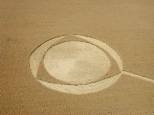Few pranks can match the creativity and intricacy of MIT's most famous hacks. When a car appears on a roof or giant stone-engraved words change overnight, pranksters everywhere show deference.
Tomorrow night (Oct. 10), the Discovery Channel will put the spotlight on the only tradition of hacks that can compare to (and in terms of scale, even outstrip) MIT's. Crop circles - the giant, geometric indentations that appear in fields around the world and which some people believe are made by extraterrestrial visitors - are the subject of the hour-long special "Crop Circles: Mystery in the Fields."
At the request of the show's producers, five MIT students conceived, built and analyzed a crop circle of their own. Dominic Rizzo, Lisa Messeri and Devjit Chakravarti, all juniors in aeronautics and astronautics, were recruited to build the circle, while Zoz Brooks and Mark Feldmeier, both graduate students at the Media Lab, were charged with analyzing the final product.
Before heading to Ohio for the TV shoot, the students spoke with members of the BLT Research Team, a Cambridge-based group of crop circle investigators. While everyone agrees that at least some crop circles are human-made hoaxes, the students learned from BLT staff that a "true" crop circle is marked not only by a complex and precise design, but by deformation of the grains of wheat and the presence of tiny iron molecules in the vicinity of the circle.
Working out of an Ohio farmer's barn and a mobile lab dubbed the "Winnebago of Science," the students built machines to reproduce these subtle indicators of "real" crop circles. Brooks, who claims an interest in amateur pyrotechnics, developed the "Flammschmeisser," a device that sprays molten iron particles. Rizzo used his own expertise to supervise construction of a device that deformed grains of wheat using parts from a microwave oven.
"The funniest part was observing how the TV people weren't quite prepared for the MIT work ethic. They wanted to film us having dinner ... but had trouble getting us to stop work to eat," Brooks said.
The team also put a lot of forethought into how their crop circle should look.
"Right away, we wanted something that only an MIT student would get," Messeri said. "Dom wanted to put a beaver in the circle, but that was decidedly asymmetric. We joked about using the Stata Center, but my involvement in theater led us to use the footprint of Kresge."
In fact, the final product does resemble MIT's unique auditorium, as if it had been created by an alien with a taste for Finnish architecture.
The analysis team was justifiably impressed with the final product. When they had completed a battery of tests on the site, the circle was deemed on a par with any of the documented cases.
"After building what we consider a damn good crop circle with almost perfectly straight lines and an interesting geometry, I find it hard to put any faith in tales of crop circle construction by aliens," Rizzo said. "I think they are a result of free time, boredom and a good sense of humor."
"Crop Circles: Mysteries in the Fields" will premiere at 10 p.m. on Thursday, Oct. 10 on the Discovery Channel. It will be rebroadcast at 1 a.m. on Oct. 11 and 4 p.m. on Oct. 12.
A version of this article appeared in MIT Tech Talk on October 9, 2002.







